Securing a crawl space door is essential for ensuring the safety and security of your home’s interior and protecting against unauthorized access or potential intruders. Crawl spaces often serve as entry points for pests, rodents, and even burglars if not properly secured.
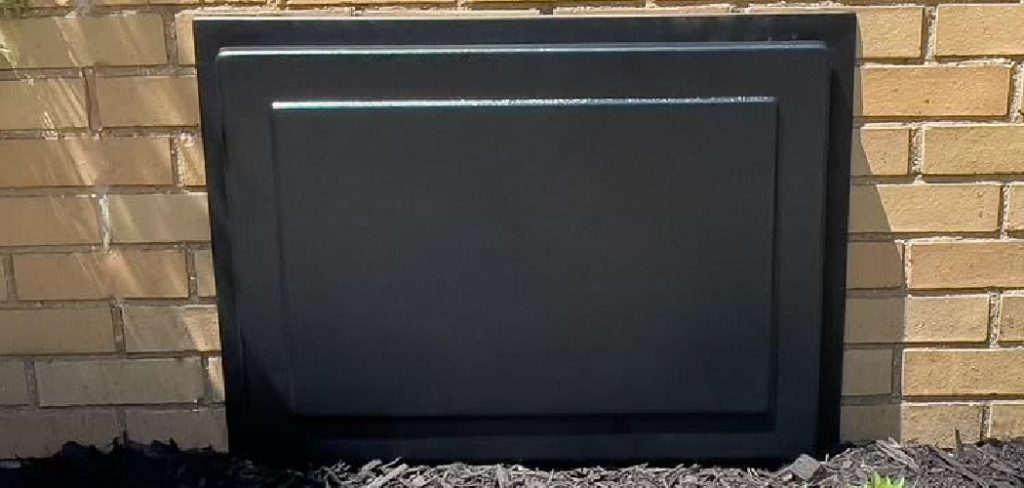
Whether your crawl space door is located inside your home or on the exterior, taking steps to reinforce it can provide peace of mind and prevent unwanted visitors from gaining entry. In this article, we’ll explore various methods and techniques for how to secure a crawl space door, including installing sturdy locks, reinforcing hinges, and adding additional security features such as alarms or motion sensors.
By prioritizing the security of your crawl space door, you can safeguard your home against potential threats and ensure the safety of your family and belongings.
Importance of Securing a Crawl Space Door
Securing a crawl space door goes beyond merely preventing physical intrusions; it plays a critical role in the overall well-being of your home. An unsecured crawl space can become a gateway for pests and rodents, which can lead to infestations that compromise the health and safety of the home’s occupants.
Moisture intrusion is another concern, as it can foster the growth of mold and mildew, potentially causing structural damage and reducing air quality within your home. Furthermore, securing the crawl space door is essential in energy conservation.
By preventing external air from entering the crawl space, you can maintain more consistent indoor temperatures, leading to reduced energy costs. In essence, a secure crawl space door not only protects against unauthorized access and enhances safety but also contributes to the structural integrity and energy efficiency of your home.
Common Vulnerabilities Associated with Crawl Space Doors
Crawl space doors are often overlooked when assessing a home’s security, yet they are susceptible to a range of vulnerabilities that can compromise the safety and integrity of your property.
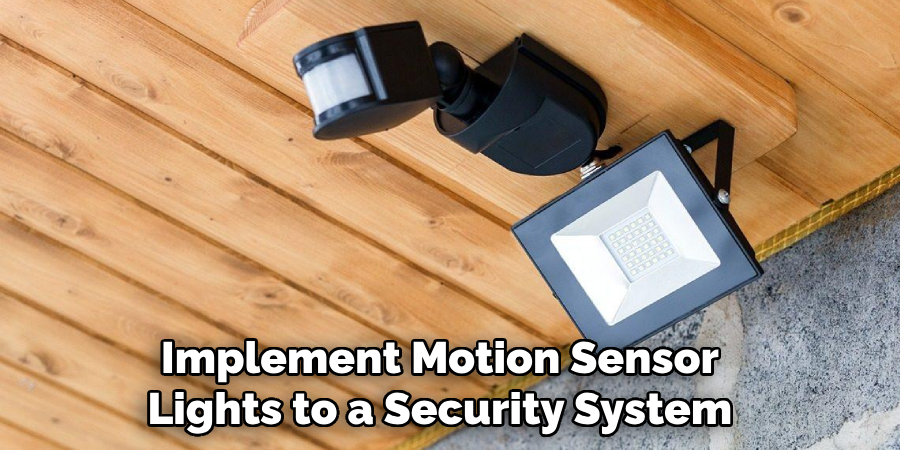
One of the primary weaknesses is the material and construction of the door itself; many crawl space doors are made from basic, thin materials that offer minimal resistance to forced entry. Additionally, the location and concealed nature of crawl spaces make them attractive targets for burglars, as they can attempt to gain access with reduced risk of detection.
Another significant vulnerability is inadequate or outdated locking mechanisms. Many crawl space doors are equipped with simple latches or basic locks that can be easily manipulated or broken by intruders. The hinges of the door, too, can be a weak point—especially if they are exposed and not reinforced, allowing someone to remove the door entirely with the right tools.
Moisture and environmental damage can also threaten the structural integrity of crawl space doors. Over time, wood doors may warp or rot, and metal doors may rust, both of which can weaken the door and make it easier to breach.
Lastly, the absence of security features like alarms or motion sensors means that even if an intruder were to attempt entry, the homeowners might not be alerted in time to respond effectively. Addressing these vulnerabilities can significantly enhance the security of a crawl space and, by extension, the entire home.
Assessing Your Crawl Space Door
Before you can effectively secure your crawl space door, it is crucial to assess its current condition and identify any potential vulnerabilities. Start by examining the door’s material and overall construction. Is it made of sturdy, durable material capable of resisting forceful entry, or is it flimsy and easily compromised? Check for any signs of damage, such as warping, rot (in the case of wood doors), rust (for metal doors), or general wear and tear.
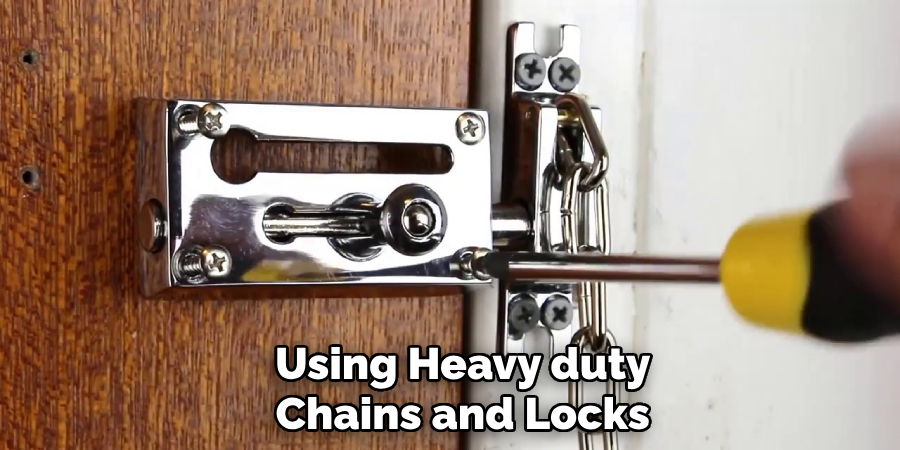
Next, evaluate the locking mechanism. Is the lock sturdy and complex enough to deter burglars, or would it be easily bypassed? Pay attention to the hinges as well; ensure they are not only in good condition but also designed in a way that they cannot be easily removed or tampered with from the outside.
Consider the door’s location and how it may affect vulnerability. Is the door easily visible to neighbors and passersby, or is it hidden and secluded, potentially offering intruders more cover? Lastly, assess for the presence of any additional security measures, such as alarm systems or motion sensors, which could deter unauthorized entry.
This comprehensive assessment will guide you in identifying specific areas that need reinforcement, allowing you to tailor your security upgrades to effectively safeguard your crawl space door against potential threats.
Understanding Crawl Space Vulnerabilities
A thorough understanding of crawl space vulnerabilities is crucial for developing effective security measures. These vulnerabilities can range from physical weaknesses in the door’s structure to the strategic positioning of the crawl space itself. Recognizing these weaknesses allows homeowners to take proactive steps toward mitigating risks and enhancing the security of their homes.
Firstly, it is vital to acknowledge the role of environmental factors in compromising crawl space security. Areas with high humidity or frequent precipitation are more prone to experience issues such as door warping, wood rot, or rust, all of which can weaken the door’s integrity over time.
Additionally, such conditions can create a welcoming environment for pests, further necessitating robust security and maintenance practices.
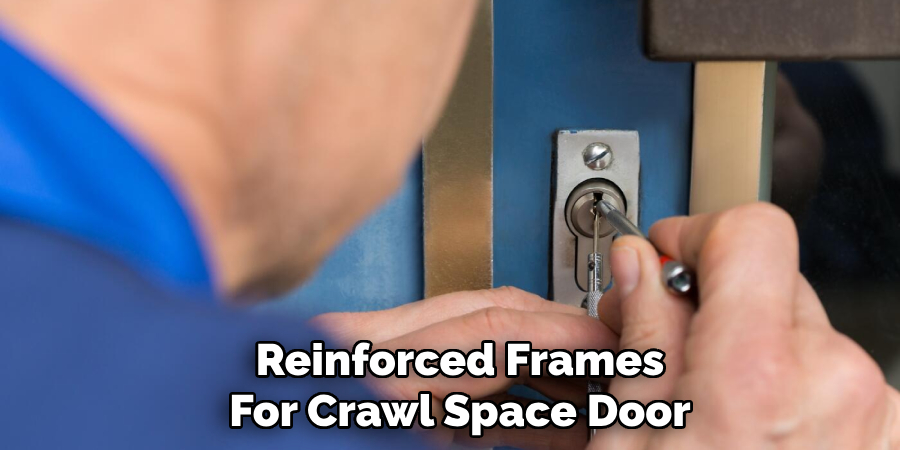
The design and installation of the crawl space door can also present vulnerabilities. Doors not properly fitted to their frames leave gaps that can be exploited for entry. Poorly installed doors might provide leverage points that intruders or pests can use to pry the door open.
Furthermore, the lack of modern security features, like electronic locks, reinforced frames, and surveillance systems, can make crawl spaces more inviting to burglars.
Understanding these vulnerabilities not only underscores the need for regular inspections and maintenance but also guides the selection of security enhancements. By addressing these weaknesses, homeowners can significantly reduce the risks associated with their crawl space and ensure a safer, more secure home environment.
Common Entry Points for Intruders in Crawl Spaces
Identifying and securing common entry points for intruders in crawl spaces is a critical aspect of home security. Intruders often seek the path of least resistance, and crawl spaces can provide such opportunities. The most common entry points include:
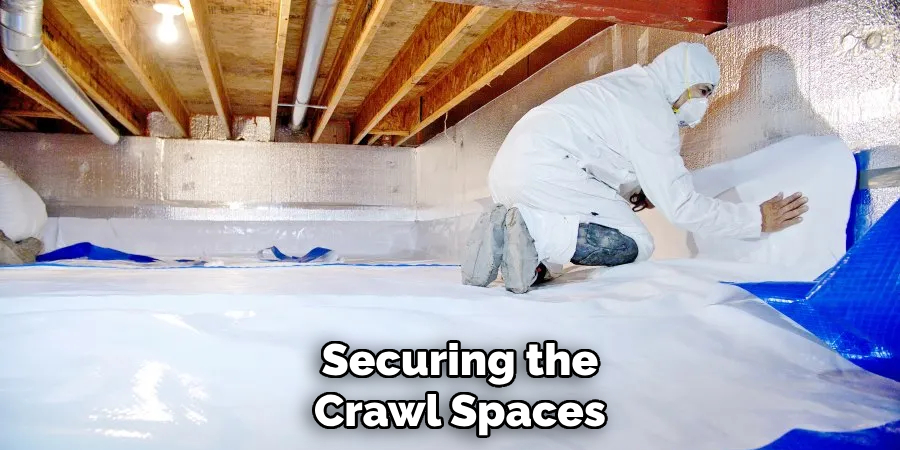
- Unsecured or Weak Doors: The main door to the crawl space is often the first target for an intruder due to its direct access. Doors that are not securely locked, are made of weak materials, or have damaged frames provide easy entry points.
- Vents and Windows: Crawl spaces sometimes include vents or windows for ventilation. These can be vulnerable if they are left uncovered, or if the screens are easily removable or damaged.
- Foundation Cracks and Gaps: Over time, a home’s foundation can develop cracks and gaps. Intruders or pests can exploit these vulnerabilities to gain access to crawl spaces, making it essential to regularly inspect and maintain the foundation’s integrity.
- Loose or Missing Access Panels: Access panels that are not securely fastened, or that have been lost or removed, can offer another easy entry point for intruders looking to gain access to a home via the crawl space.
Securing these entry points involves a combination of regular maintenance, upgrading materials and locks, and incorporating modern security features. By focusing on these vulnerable areas, homeowners can significantly enhance the security of their crawl spaces and, by extension, their entire home.
Importance of Addressing Vulnerabilities in Crawl Space Doors
Addressing vulnerabilities in crawl space doors is paramount for several reasons, primarily because it directly impacts the overall security and integrity of the home. Firstly, the crawl space can serve as a critical entry point for intruders if not properly secured.
By identifying and reinforcing weak spots, homeowners can deter break-ins and protect their property and loved ones from potential harm. Secondly, vulnerabilities in crawl space doors can lead to environmental damage, such as moisture intrusion, which fosters the growth of mold and mildew, thereby compromising the home’s air quality and structural integrity.
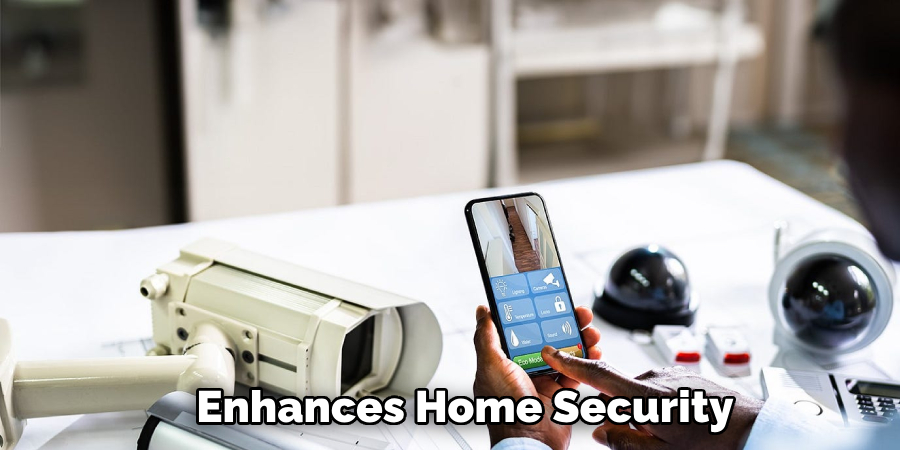
Lastly, pests and rodents often exploit these weaknesses to gain entry into the home, leading to infestations that can cause health issues and necessitate costly extermination services. Proactively addressing these vulnerabilities not only enhances home security but also contributes to the preservation of the property’s value and the well-being of its occupants.
Legal and Safety Considerations
When securing crawl space doors and addressing vulnerabilities, homeowners must also consider the legal and safety implications involved. Compliance with local building codes and regulations is essential to ensure that any modifications or enhancements do not violate legal standards.
These codes often specify requirements for materials, installation processes, and security features to ensure they meet safety and durability standards. For example, certain areas might mandate the use of fire-resistant materials or specific locking mechanisms that comply with emergency egress standards.
Furthermore, safety considerations should be at the forefront of all security upgrades. This includes ensuring that any changes do not obstruct or complicate access in case of emergencies.
For instance, while securing a crawl space door against unauthorized entry is crucial, it’s equally important to ensure that the door can be easily opened from the inside without special tools or keys, in compliance with fire safety regulations.
9 Methods How to Secure a Crawl Space Door
1.Upgrade Locking Mechanisms:
Replace standard locks with high-security options like deadbolts or padlocks. Deadbolts provide extra strength and resistance to forced entry, while padlocks offer versatility and portability. Opt for locks made of sturdy materials such as hardened steel to withstand tampering attempts.
2.Install Security Bars or Grilles:
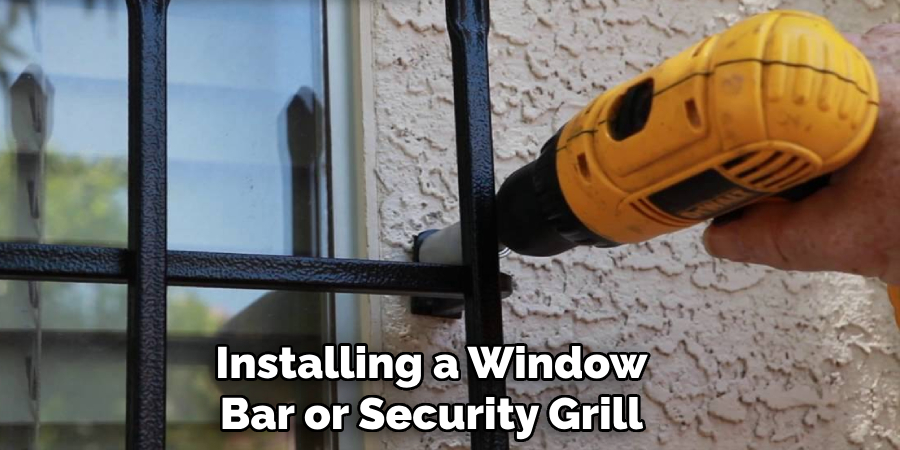
Enhance the security of your crawl space door by installing sturdy security bars or grilles. Choose bars or grilles that are specifically designed for crawl space doors and are made of durable materials like steel. Ensure they are securely anchored to the door frame to prevent unauthorized access.
3.Reinforce Door Material:
Strengthen the door material to increase its resistance to forced entry. Install metal reinforcement plates or bars on the inside of the door to fortify weak areas. Consider upgrading to a solid-core door or adding a metal door guard for added durability and security.
4.Secure Hinges and Hinge Pins:
Prevent intruders from removing the door by securing the hinges and hinge pins. Install security hinges with non-removable pins to thwart attempts to disassemble the door. Alternatively, add hinge pin locks or hinge bolts to reinforce the hinges and prevent tampering.
4.Enhance Lighting and Visibility:
Improve the lighting around the crawl space door to deter intruders and enhance visibility. Install motion-activated lights or LED floodlights near the door to illuminate the area effectively. Position the lights strategically to cover entry points and blind spots, making it difficult for intruders to approach undetected.
5.Implement Access Control Measures:
Regulate entry and exit through the crawl space door by implementing access control measures such as keyless entry systems or keypad locks. These systems allow you to control access to the crawl space and monitor who enters and exits. Choose options with advanced features like remote access and activity logging for added security.
6.Conceal and Camouflage:
Make the crawl space door less conspicuous by concealing it with landscaping, fencing, or camouflage netting. Use natural elements like shrubs and bushes to hide the door from view, making it harder for intruders to locate and access. Ensure the concealment does not impede ventilation or access in case of emergency.
7.Use Door Alarms or Sensors:
Install door alarms or sensors to detect unauthorized entry attempts and alert you to potential break-ins. Choose from a variety of options, including standalone alarms, wireless sensors, or integrated security systems. Opt for alarms with adjustable sensitivity settings and remote monitoring capabilities for added convenience and peace of mind.
8.Add a Door Sweep:
Seal any gaps at the bottom of the crawl space door with a durable door sweep. Door sweeps prevent pests, moisture, and intruders from entering through gaps in the door. Choose a sweep made of weather-resistant materials like rubber or vinyl to ensure longevity and effectiveness.
9.Regular Maintenance and Inspection:
Maintain the security of your crawl space door by regularly inspecting and maintaining all security measures. Check the condition of locks, hinges, and other security hardware for signs of wear or damage.
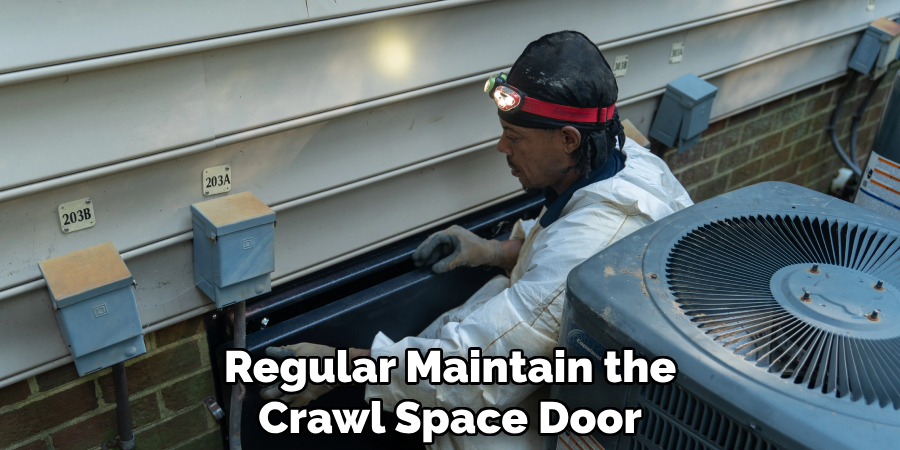
Repair or replace any components as needed to ensure they remain effective in deterring intruders. Additionally, periodically review your security measures and make adjustments as necessary to address any emerging threats or vulnerabilities.
Common Mistakes to Consider When Securing a Crawl Space Door
While securing a crawl space door is crucial for home safety and pest control, there are several common mistakes homeowners might make during the process. Overlooking these pitfalls can render your efforts less effective or even compromise your home’s security:
- Ignoring Door Frame Security: Focusing solely on the door itself without considering the strength and integrity of the door frame is a common oversight. A reinforced door is only as secure as the frame it’s attached to. Ensure the frame is also reinforced and in good condition to prevent intruders from exploiting weak points.
- Neglecting Regular Maintenance: Failing to regularly check and maintain the door, locks, and other security features can lead to vulnerabilities. Weather, use, and time can wear down even the best security measures, making regular inspections and maintenance essential for ongoing protection.
- Overlooking Interior Security Measures: While much attention is given to securing the exterior of the crawl space door, internal security is often neglected. This includes ensuring easy egress in emergencies and safeguarding against internal threats such as pests or moisture.
- Choosing Inadequate Locks or Security Systems: Opting for cheaper or lower-quality locks and security systems can be tempting to save money. However, these may not provide adequate protection against determined intruders and can be easily bypassed.
- Blocking or Hiding Emergency Exits: While concealing the crawl space door can deter intruders, it’s vital not to obstruct access to such an extent that it becomes difficult to use the door in emergencies. Ensure that any concealment methods allow for easy identification and access by occupants in case of an emergency.
- DIY Installations Without Proper Knowledge or Tools: Undertaking security enhancements without a clear understanding or the right tools can lead to suboptimal installations that compromise the door’s security. Consulting with professionals or thoroughly researching best practices is recommended for effective and safe installations.
Conclusion
In conclusion, securing a crawl space door is a vital step in maintaining the safety and security of your home. By implementing the methods and techniques outlined in this article, such as installing sturdy locks, reinforcing hinges, and adding supplemental security measures like alarms or motion sensors, homeowners can effectively deter unauthorized access and protect against potential intruders or pests.
Regular maintenance and periodic checks of the crawl space door’s hardware and security features are also crucial for ensuring continued effectiveness. Thanks for reading, and we hope this has given you some inspiration on how to secure a crawl space door!
About
Safety Fic is a distinguished figure in the world of Diy design, with a decade of expertise creating innovative and sustainable Diy solutions. His professional focus lies in merging traditional craftsmanship with modern manufacturing techniques, fostering designs that are both practical and environmentally conscious. As the author of diy, Safety Fic delves into the art and science of Safety Fic-making, inspiring artisans and industry professionals alike.
Education RMIT University
(Melbourne, Australia) Associate Degree in Design (Safety Fic) Focus on sustainable design, industry-driven projects, and practical craftsmanship. Gained hands-on experience with traditional and digital manufacturing tools, such as CAD and CNC software.
Nottingham Trent University
(United Kingdom) Bachelor’s in diyfastly.com and Product Design (Honors) Specialized in product design with a focus on blending creativity with production techniques. Participated in industry projects, working with companies like John Lewis and Vitsoe to gain real-world insights.
Publications and Impact
In diy, Safety Fic his insights on indoor design processes, materials, and strategies for efficient production. His writing bridges the gap between artisan knowledge and modern industry needs, making it a must-read for both budding designers and seasoned professionals.
